Start by copy pasting the route in to another map applications to get a quick overview of where there are deviations. Focus on investigating these deviations, especially if they are ranking high on the “potential error list”. But be aware of situations where the difference is just from a different preference of route, some map applications just seem to prefer certain type of roads etc. If you do not recognize what is an obvious preference difference, you can end up doing a lot of unnecessary investigation where there is no real issue. Sometimes adding 1-2 extra stops can get around this issue and then compare like for like routes with less “normal” deviations.
Approach rating efficiently by evaluating the route and identifying the high-risk areas. Start by looking at these for an MNE. What are high risk areas?
Obviously, you should not rule out anything but spending time on these, instead of tracking the routing along a major road, especially rural ones, where perhaps two other map applications agree with the routing, is simply more effective way of evaluating the route.
Misalignments are considered MNEs when the misalignment is more than 50 meters from blue route line to the ’present day’ ground truth. It is very common for the blue route line to be misaligned along long stretches of the route. It is very important to scan thoroughly even the sections that follow major roads without turns. Often the misalignment is less than 50 meters, in which case it should be rated as a minor issue, but the misalignment distance should always be measured. If it is more than 50 meters, a comment and the coordinates are required. This is one type of misalignment. See the Guidelines section 4.1.1. for the definitions of the other types.
Below is an example where the route passes through a restricted access area. There are gates at points shown by the red arrows, which prevent an average driver to pass through. Since this is not the start nor destination point of the route, it is marked as an MNE – Access Restricted.

U-Turns are often allowed in Finland. When there is a U-Turn in a route, the location needs to be checked to see if there is a problem with this manoeuvre. Often a U-turn appears in the beginning of the route. U- Turns can be prohibited with a specific sign.
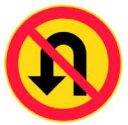
It is also prohibited when there is a sign prohibiting turning to the left, when there is a continuous yellow line dividing the lanes and within tunnels.
For example here a U-Turn would be illegal as there is a continuous yellow line in the middle of the road.

Turn restrictions are always indicated with traffic signs. Therefore any turns that can’t be confirmed by painted arrows/turn channels on satellite images, should be checked on street view.
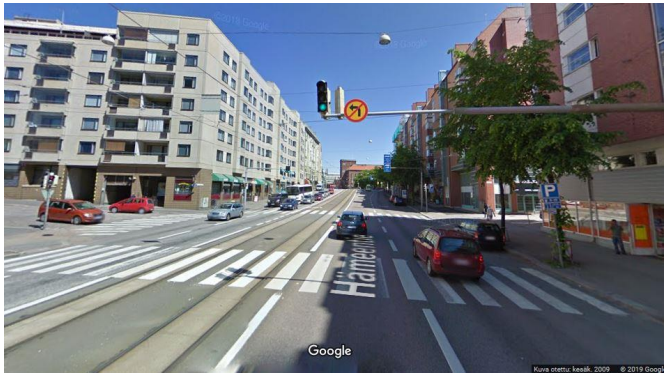
In this case the route told the user to take the left turn here. See also the screenshot below.
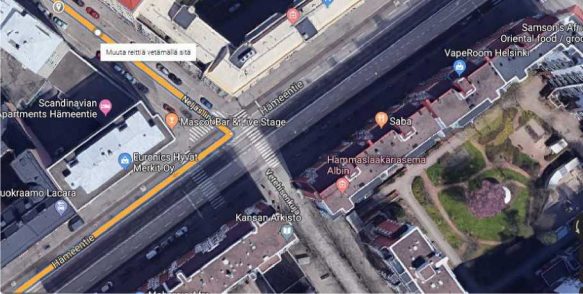
It also possible that there is a turn restriction during certain hours. For example from 7am until 7pm. If this was the case, it would be indicated in the same traffic sign.
Many times the suggested route uses pedestrian/bicycle roads. Any suspicious sections should be checked on street view, as often the pedestrian areas seem wide enough for a car. For example in the screenshots below the pedestrian zones might seem like streets for cars on satellite image but street view images clearly have signs that indicate that these roads are only allowed for pedestrians or cyclists.

Another example of Cars Not Allowed MNE are neighbourhoods/apartment complexes that have signs that prohibit driving through the zone. In these cases cars are only allowed to enter or exit properties within the zone. For example the following route would be considered MNE Cars Not Allowed as there is a sign like this along the route.
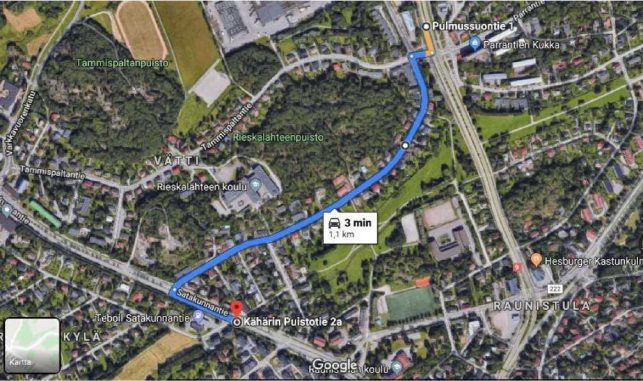
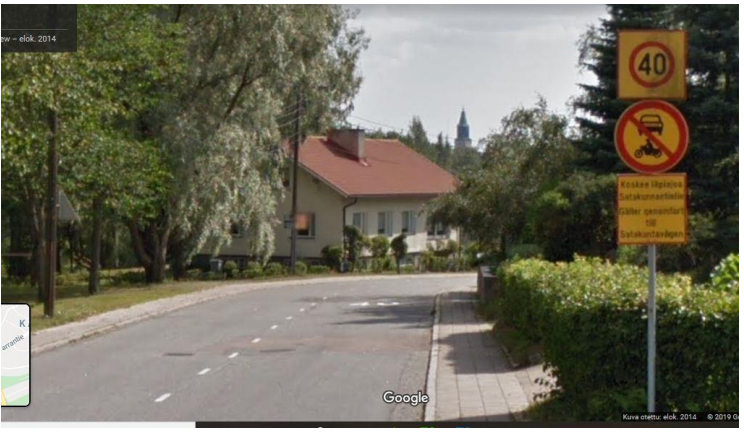
The following sign is used to indicate that driving this way is not allowed.
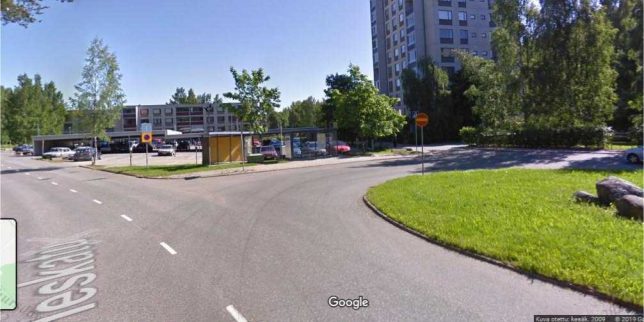
If the route adviced us to turn to the right here, it would be considered MNE against traffic rather MNE turn restriction. See Guidelines section 5.1.
Below is an example where the route goes through a forest where there is no road in the area shown by the red arrow. Moreover, the route crosses a river at the point shown by the yellow arrow where there is no bridge there. There is thus an MNE – Physically Impossible on this route.

Below is an example where the route looks like physically impossible in the upper 2013 aerial image. However, when one investigates the newer lower image from 2017, it is found that a new junction has been built and the route actually follows nicely the current road network. This is thus NOT an MNE in this case. Remember always evaluate the route against the current real world.


Some routes include a pedestrian part, which is indicated it in the instructions, so the route is rated normally. You’ll need to check the steps to see if they mention Prepare to Park or any other instruction related to Walking. Mainly in the cases where route takes user to where cars are not allowed.
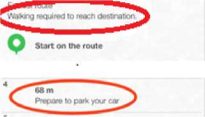
Whenever an MNE is discovered, the analyst is requested to leave a comment that includes the Step ID and brief explanation of the MNE, and links to any supporting evidence. Examples of good comments are provided in the table below.
MNE | Comment |
Major Road Misalignment | At Step N, 60.111111,24.222222, the route misses a roundabout larger than 50 m in diameter. [link to resource] At Step N, 60.111111,24.222222, the route misses a turn channel that measures more than 100 m from the beginning to the end of the turn channel divider. [link to resource] At Step N, 60.111111,24.222222, the route misses a turn channel, because there exists a point along the center of the turn channel lane, from which the |
distance to the closest point on the blue line is more than 50 m. [link to resource] | |
Physically Impossible | At Step N, 60.111111,24.222222, the route uses a road that does not exist in the real world. [link to resource] At Step N, 60.111111,24.222222, the user is requested to make a manoeuvre which is no more possible because the road network has changed, as can be verified from more recent satellite images [link to resource]. |
Access Restricted | At Step N, 60.111111,24.222222, the route travels through an area restricted only to residents, as can be verified from street level images [link to resource]. Because the route does not start or end within the restricted area, this is an MNE. |
Cars Not Allowed | At Step N, 60.111111,24.222222, cars are not allowed to use the pedestrian only walkway indicated by the traffic sign visible in the street level images [link to resource]. |
Against Traffic | At Step N, 60.111111,24.222222, the route goes against traffic as there is a traffic sign forbidding driving this way, see the street imagery [link to resource]. |
Illegal U-Turn | At Step N, 60.111111,24.222222, it is illegal to make a U-turn on a motorway. [link to resource] At Step N, 60.111111,24.222222, there is a traffic sign, which prohibits U- turns, as can be verified from street imagery [link to resource]. |
Turn Restriction | At Step N, 60.111111,24.222222, it is not allowed to turn left between 6 – 18 hours any day of the week, as indicated by the traffic sign visible in the street level images [link to resource]. Since the user will reach this step during the time of restriction, this is an MNE. |
Other | At Step N, 60.111111,24.222222, [provide a detailed explanation what is wrong with the route]. [link to resource] |